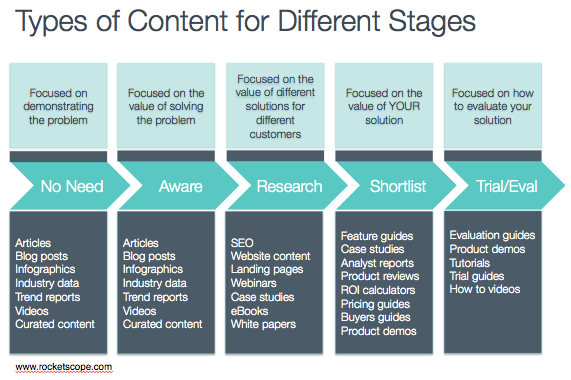In the past year we’ve seen a shift in the way startups are thinking about content marketing. Two years ago most of the content marketing conversations I had with startups started out as discussions about SEO, ranking and keywords. Content quality from a prospect point of view was largely an afterthought. A lot of that thinking has changed both because of apparent changes to the Google algorithm, as well as changes in the way buyers behave online where they are increasingly bombarded with not just too much content, but too much crappy, irrelevant and downright useless marketing content. Getting found by prospects on the internet is (finally) becoming less a matter of sneaky tricks to game Google and more a battle to provide informative, useful content that prospects seek out, enjoy and gleefully share among their peers.
But many startups don’t know where to start. In my experience the best way for a startup to begin building a content library is to put themselves in the minds of their prospects and think about what content is needed at different stages of the buying process.
Understanding the Buyer’s Journey
One of the most common mistakes I see startups make with their content is that they create too much content that focuses only on one particular stage of the buyer’s journey.
For a startup selling to businesses, typically a buyer will move through a set of stages on the way to making a purchase. This is increasingly not a linear journey as a buyer may move back and forth between actively researching solutions, building a short list of possible vendors and actively evaluating a particular solution. At each stage there are factors that may propel a buyer closer to a purchase (I call these accelerators) and others that can slow a buyer down or drive them backward to a previous stage (I call these friction points). Here’s an example of what I mean by that:
Increasingly buyers are moving through these stages without direct contact with a vendor. They are researching and consuming content online that comes to them from their friends, colleagues, through internet searches and through their social networks. Your only chance of capturing their attention in these early stages is to make sure that your content is found by your prospects while they are in this process. Creating content that meets their needs at their particular point in their buyer cycle is the key to getting their attention.
Mapping Content to Different Stages of the Buyer’s Journey
For each stage of the journey there are different types of content that prospects will find useful. In the earliest stages, where a prospect doesn’t understand that they have a problem that needs to be solved yet, your content needs to be focused on highlighting the risk of not solving the problem or the value of solving it. Next the prospect needs to understand that there are solutions that are appropriate for them in terms of price, complexity, benefits. As the buyer moves toward creating a shortlist of vendors to evaluate they become more interested in consuming content that focuses on specific features and why they might choose your offering over other offerings in the market.
Typical Problems: Content Clustered Around the Earliest or Latest Stages of the Buying Process
Typically what we see in startups is that the content that a startup has created is clustered around a particular stage in the purchase process, often with litter consideration about whether or not that is a place where prospects are getting stuck.
Some startups have their content too heavily focused around their own offering. Content such as detailed whitepapers, product feature sheets, competitive comparisons and buyers guides are examples of this type of content that is really only relevant to prospects in the later stages of a buying process. The problem with this approach is that the startup misses out on prospects at earlier stages that don’t yet understand the offering or the value it might provide them. As a result, Prospects never make it to the point in the buying process where they are willing to invest in such meaty, solution-oriented content.
For other startups, the content is too heavily focused on the early stages. Content such as infographics, funny videos and short humorous blog posts are examples of this type of content. The problem with this is that although the early funnel metrics might look good as a result (loads of traffic and social shares), prospects may get stuck later in the funnel when they need meatier content to help them make a purchase.
Now think about your startup – do you have content that is clustered around a single point in the buyer’s journey? Do you have an understanding of where prospects are getting stuck in their journey and are you providing content that helps move them along?




The link for the
Simply amazing material. You have done a wonderful job. As a startup (ChurchScene), we will implement this structure to fit our marketing plan. Thank you.